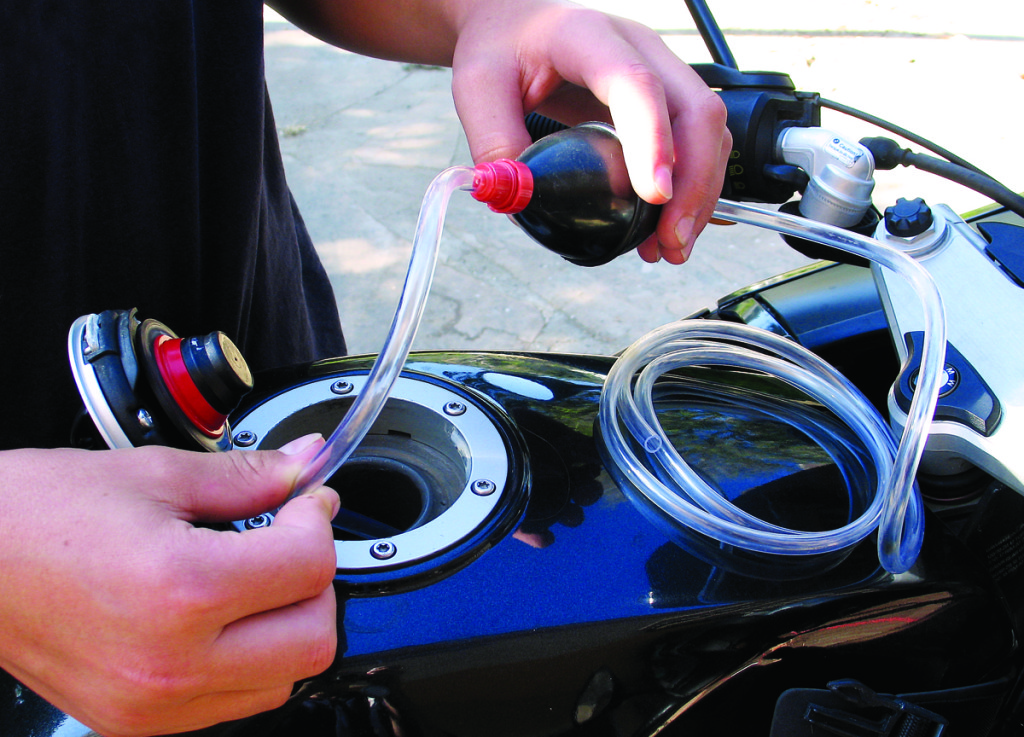 You are out on the Highway, enjoying your getaway when suddenly your motorcycle stalls. What to do? Fortunately, the four most common road emergencies can usually be prevented by regular inspection and maintenance, but here’s what to do when that doesn’t work. FROM www.ridermagazine.com
You are out on the Highway, enjoying your getaway when suddenly your motorcycle stalls. What to do? Fortunately, the four most common road emergencies can usually be prevented by regular inspection and maintenance, but here’s what to do when that doesn’t work. FROM www.ridermagazine.com
1. Out of Gas
Run out of gas on the road and you’ll need a donor bike and a transfer device. To siphon, the fuel level in the donor bike must be higher than the level it will reach in the recipient bike; place the donor bike on a curb or rise. Carry a siphon hose, at least three feet of flexible, transparent hose that is easy to coil and stow under a seat or in a fairing pocket. Get one with a squeeze bulb and you won’t need to undergo the potentially disgusting ritual of siphoning raw gas with your mouth.
To avoid mouth siphoning immerse the hose deep into the donor bike’s fuel supply, cap the other end with your thumb and begin to slowly draw out the hose and lower it into the recipient bike’s fuel tank. Remove your thumb once the level of fuel in the hose drops below the top level of the fuel in the donor bike (that’s why a transparent hose is best), and the fuel will begin to flow.
If this is not possible, drain fuel into whatever is handy, such as a beverage container, sidecover or tool tray by removing a fuel line and turning on the petcock. This may not be possible if the donor bike has a vacuum-flow system. Rinse the container thoroughly with gasoline, and be certain ol’ Jimbo ain’t lightin’ up during this procedure.
Tools: Siphon hose
Prevention: Check the gauge, dummy! Zero your bike’s trip odometer when you fill up, and it will show the elapsed mileage.
2. Flat Tire:
Establish whether your bike has tube or tubeless tires. For the past few decades, most bikes with cast wheels have carried tubeless tires, while most with wire spoke wheels have had tube-type. If it’s a tube-type, you’ll have to “break the bead,” pull the tire away from the wheel (pack tire irons) far enough to expose the puncture in the tube. This may mean removing the wheel from the bike. Roughen the area around the puncture with the tool supplied in the patch kit and apply cement. Wait momentarily till the glue becomes tacky, and apply the patch.
For a tubeless tire, it’s only necessary to remove the nail and insert the tool from the patch kit to enlarge and roughen the hole. Cover a plug with cement and insert. Cut off excess and add air. The three methods of doing so are with CO2 cartridges, an electrical pump that runs off the battery and a hand pump.
Tools: Toolkit, tire patch kit, tire irons, air supply
Prevention: Inspect tire tread frequently for depth and foreign objects, and check pressure regularly. The last 10 percent of tire life results in 90 percent of the problems.
3. Low Oil:
Suddenly the oil light comes on. You’re a quart low—oops! Rodney has a quart along, but your bike runs that expensive 20W-50 synthetic bike oil and his is 40W cheapo car oil. Can you mix them?
The answer is yes. Considering that the alternative is either serious engine damage or sending someone on a 100-mile goose chase, mixing will not harm the engine, though it will dilute the properties of the high-quality oil. Change oil and filter at your earliest convenience.
Tools: Rag, funnel, extra quart
Prevention: Check oil
4. Sudden Engine Stop, Reason Unknown
A sudden engine cutout usually boils down to fuel or electricity. Check fuel supply, check for a clogged gas cap vent (does opening the cap suddenly and temporarily “solve” the problem?) or fuel filter. If your bike is carbureted and there’s fuel in the float bowl(s), the problem likely resides elsewhere.
Turn on the ignition and see if your bike has lights, horn and starter. If not, check that battery cables are tightly connected and clean. If your battery isn’t maintenance-free, are the cells properly topped up with distilled water? Spray WD-40 on the sparkplugs, wires and coils to displace any water.
If the lights and horn are strong, check fuses (know your bike’s fuse box location, and carry spares). With a clip lead and light, clip the lead to ground (a piece of bare metal on the engine) and place the point on either side of the fuse with the ignition on. If there’s power on both sides, the fuse is good.
If the starter cranks but the engine does not start, use the clip lead to establish if there is juice at the coils. If so, pull the spark plugs and establish if they’re sparking. If not, trace the wires back to the last place where there was electricity, then inspect upstream for bare wires or breaks. Listen and watch for obvious stray sparks. Wrap broken wire with tape to get you home.
Tools: Clip lead, electrical tape, fuses, WD-40
Prevention: Pray
And, of course, whenever you go for a ride, carry a cell phone, credit cards and some spare cash–sometimes calling in the cavalry is your only option. It’s also a good idea to have coverage with a roadside assistance plan, such as the one that’s included with annual membership at the American Motorcyclist Association.